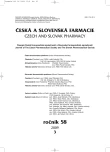Formulation of chlorhexidin into gels
Authors:
Z. Vitková; P. Herdová; M. Šubová; V. Šimunková
Authors‘ workplace:
Univerzita Komenského v Bratislave, Farmaceutická fakulta, Katedra galenickej farmácie, SR
Published in:
Čes. slov. Farm., 2009; 58, 116-118
Category:
Original Articles
Overview
The paper deals with the selection of optimal auxiliary substances from the group of enhancers and humectants for the formulation of chlorhexidin into the dosage form chitosan hydrogel. The concentrations of the active ingredient and the gel-producing substance are always constant, 0.1% (m/m) and 2.5% (m/m), respectively. The active ingredient chlorhexidin is one of the most widely used antiseptic agents to treat the inflammations of the oral cavity. The paper evaluated its release from hydrogels without and with Polysorbat 80 in 0.1 and 0.5% (m/m) and glycerol in 10% (m/m). The content of the active ingredients was determined spectrophotometrically, the optimal composition of hydrogel being: 0.1% chlorhexidin + 2.5% chitosan + 0.1% Polysorbat 80, where the largest amount of the active ingredient was released and this hydrogel showed thixotropic properties desirable from the standpoint of administration.
Key words:
chlorhexidin – chitosan – liberation – Polysorbat 80 – rheological properties
Sources
1. Senel, S. et al.: Int. J. Pharm., 2000; 193, 197–203.
2. Cristallini, C. et al.: J. Appl. Biomater. Biomech., 2007; 5, 184–191.
3. Wang, T., Turhan, M., Gunasekaran, S.: Polym. Int., 2004; 53, 911–918.
4. Schuetz, Y.B., Gurny, R., Jordan, O.: Eur. J. Pharm. Biopharm., 2008; 68, 19–25.
5. Vitková, Z., Šubová, M., Halenárová, A.: Farm.Vestn., 2008; 59, 283–284.
Labels
Pharmacy Clinical pharmacologyArticle was published in
Czech and Slovak Pharmacy

2009 Issue 3
Most read in this issue
- Ointments in medieval Europe
- A short introduction to algal and cyanobacterial constituents – the occurrence of phenolic metabolites
- Review of hydroxamic matrix metalloproteinase inhibitors and their therapeutic potential
- A clinical study of the relationship of selenium plasma level to atopic dermatitis, a comparison of the results of determination using the methods of galvanostatic dissolution chronopotentiometry and atomic absorption spectrometry
